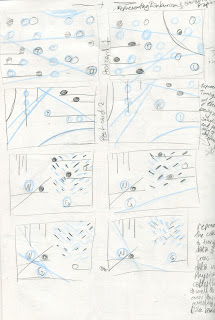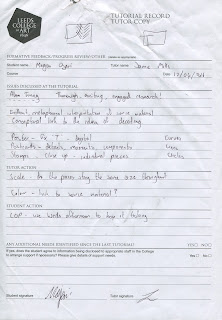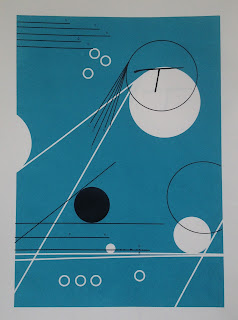|
|
|
Leeds College of Art
BA (Hons) ILLUSTRATION
|
Level
|
04
|
|
OUIL406 Visual Communication
|
Credits
|
20
|
|
End of
Module Self Evaluation
|
||
|
NAME
|
Megan
Ojari
|
|
1. What have you learn about visual
communication during this module and how effectively do you think you have
applied these ideas?
This module has taught me
mainly about simplifying my ideas to strip a message down to the minimum
information needed to communicate the intent. I also have learnt about the
importance of communicating my core idea and response to the brief through my
final, resolved outcomes. In addition, this module has taught me about
working independently, and asking peers, tutors and friends for feedback when
I need it. Because we had a lot of time to work without outside motivation, I
found it taught me to motivate myself. The broad briefs of this project also
made me to think of new ways to approach problems and think ‘outside the
box’, which will be valuable in my future practise.
|
|||||
|
|
|||||
|
2. What approaches to/ methods
of image making have you developed and how have they informed your concept
development process?
This module has definitely improved
my technical skills, particularly my confidence in using Illustrator and
screen printing, both of which I thoroughly enjoyed using and will
incorporate more into my future practise. I also experimented for the first
time with moving image during the GIFs project, of which I enjoyed the 3D
element, as I liked understanding the mechanics of a product and how it functions
as a whole. I think working three dimensionally and understanding form is
really important within illustrator’s practise. The skills I have learnt over
these briefs have also tested my ability to reflect on my practice through
the process of blogging, and establishing an internal conversation about my
work and progress on the course.
|
|||||
|
|
|||||
|
3. What strengths can you
identify in your work and how have/will you capitalise on these?
I think my final outcomes are
the strongest element of my submission, as I have combined my visual research
into resolved outcomes which fit the brief. I have also explored my character
more during the first brief, which I am not confident in, but through working
exclusively with character, I have improved my confidence with developing a
character and transferring it across different media. My skills in
Illustrator have also improved, as before this module I had never used it,
but I now really enjoy using the software, and feel confident in the basics.
Another strength in my submission is time management, as through using
timetables, I have ensured I am not rushing at the end to finish my work. I
also feel that my thorough primary research for the Persons of Note brief
ensured I had a strong starting point to develop from, which helped to inform
my practise and unearthed unusual, highly theoretical aspects of Turing’s
life, which I wouldn’t have arrived at without this research.
|
|||||
|
|
|||||
|
4. What weaknesses can you
identify in your work and how will you address these in the future?
|
|||||
|
Some weaknesses of this submission
are how I started the first two briefs, as I was lacking inspiration and
struggled to grasp an idea I was happy with. However, something changed
during the Persons of Note brief, and I really enjoyed my work and was happy
with the direction it was heading in. I think in order to ensure I stay
motivated and happy throughout the rest of this course, I will make sure that
I do what I want within the brief by stretching it to fit with my practise. I
also feel I didn’t explore different ideas enough, as I think through more
roughing and media exploration I could have pushed myself further. Another
weakness was my regard to scale, as until my tutorial with Jamie during
Persons of note, I hadn’t really considered the appropriateness of scale
within my work, and I wasn’t working to effective scales. My research for the
first two briefs was also lacking substance, and I could have done wider
research of both images and illustrators to inform my practise. I also think
I could have made time after the final critiques to tweak my final pieces to
reflect the feedback of my peers.
|
|||||
|
5. Identify five things that
you will do differently next time and what do you expect to gain from doing
these?
|
|||||
|
-Next time I will plan my time from the start, as I
found it so helpful to have an effective timetable during the last brief and
found sticking to it fairly easy and incredibly useful. During my next
project I will create a detailed timetable of both in and out of college activities
at the start.
- I will make sure I don’t stress during my image
experimentation, and remember it’s ok to get things wrong, and that’s
actually what teach me the most about my practise and help me grow as an
illustrator.
-During this module I have been a lot more
confident in showing my work to peers, and getting feedback, which is
something I struggled with a lot previously, but by getting to know my peers
and through establishing more of an online presence with my work, I’ve
realised that, the feedback is either good or bad, and if it’s not
complimentary, then it is an opportunity for me to change things and learn
from what wasn’t so successful the first time round and grow from it.
-I also need to make sure I research some more
illustrators at the beginning, as often when I look at their work it is after
I have made some critical decisions on my work, which may have been different
had I reflected on other practitioners work first.
-After reflecting on my last feedback session, I
will spend some time over the remaining weeks and over the summer about where
my personal practise sits within the creative field, and how I can work to
create images I love and that inspire me to keep working.
|
|||||
|
6.How would you grade
yourself on the following areas:
(please indicate using an
‘x’)
5= excellent, 4 = very good,
3 = good, 2 = average, 1 = poor
|
|||||
|
|
1
|
2
|
3
|
4
|
5
|
|
Attendance
|
|
|
|
|
x
|
|
Punctuality
|
|
|
|
x
|
|
|
Motivation
|
|
|
x
|
|
|
|
Commitment
|
|
|
|
x
|
|
|
Quantity of work produced
|
|
|
|
x
|
|
|
Quality of work produced
|
|
|
x
|
|
|
|
Contribution to the group
|
|
|
|
x
|
|
|
The evaluation of your work is
an important part of the assessment criteria and represents a percentage of
the overall grade. It is essential that you give yourself enough time to
complete your written evaluation fully and with appropriate depth and level
of self-reflection. If you have any questions relating to the self-evaluation
process speak to a member of staff as soon as possible.
|
|||||
































